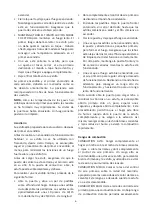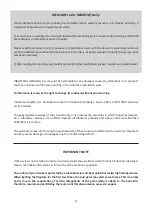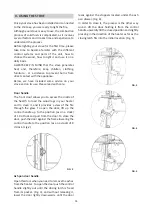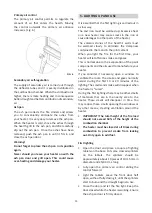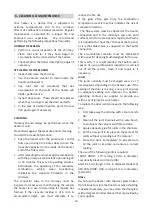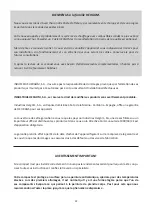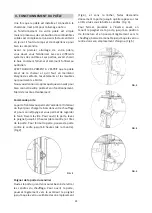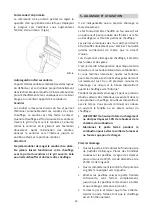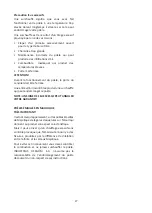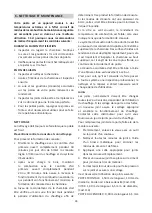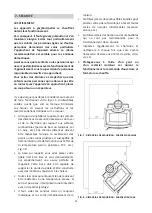
16
• AT ALL TIME KEEP YOUR EYES ON YOUR HEATER
to keep a low fire. The first fire must heat the
heater but it should not burn when you touch
it. You should add some pieces of wood to the
fire to reach an adequate temperature in the
first lighting.
• Once the heater is hot, but does not burn to
the touch, close the primary air by sliding the
control to the limit inwardly, and let the fire
completely go out.
• Let your heater cool down entirely.
The first time you light it and the first lighting of
each season, must be carried out as previously
described. Your patience will be compensated by
years of a good operating of your heater.
NOTE:
as the gas temperatures have been low
during the first lighting, the creosote has formed
quickly. The glass on the door has probably got
dirty. A subsequent hot fire will clean it.
Daily use
Before carrying out a regular lighting operation,
if your heater has not been used often, for a long
time, it is recommendable to follow the first lighting
procedure, at least, to minimize the tensions of a
strong fire on a cold heater.
Before loading the heater, ensure the ash pan door
is closed and the ash pan is in its place. If the ash
pan door should open, the heater could over-heat
and get damaged.
To perform a normal lighting, do so in the following
way:
• Open the door and place a couple of tablets on
the hearth’s base. Put some crossed splinters
on some newspapers. The splinters should be
approximately about 10 pieces of 10/15 mm in
diameter and 25/40 cms. long.
• Fully open the primary air control by moving
the control towards the front.
• Light the tablets up. Leave the front door half
open, without fully closing it, until the splinters
start to burn and the draught begins to rise.
• Close the door and let the fire light.
• Once the splinters have caught fire, open the
door and add logs, first small ones, to form
the fire. Make sure the logs are far from the
glass, so that the glass’s cleaning system works
correctly. On the other hand, keep the front
door and the ash pan door closed while the
heater is operating.
• Once the fire is well lit, use the primary air to
regulate the level of operating desired. Moving
the control towards the front, to obtain a high
level of operating, and inwardly for a low level
of operating.
Note: When you open the door to load the wood or
replace the logs in your heater, it is recommendable
to first open only a little, wait a few seconds and
then after open it wide. This procedure will permit
the hearth to be free of smoke when you open
the heater door wide and so it does not fill the
room. Likewise, to reload on a bed of hot and red
embers reduces the smoke and will intensify the
combustion rapidly.
Combustion levels
HIGH COMBUSTION: Fully load the hearth with
wood on the hot and red ember bed or on the
flames and entirely open the primary air control.
A high level is recommended once or twice a
day to heat the chimney and the heater up well,
preventing the creation and accumulation of
creosote.
MEDIUM COMBUSTION: Place the primary air
control lever at the middle of the run, appropriate
for the heating needs of the area to be warmed.
This level is adequate when the heater is going to
be unattended.
LOW COMBUSTION: Close the primary air control
for a slow combustion. A low combustion level
during excessively long periods is not convenient
as it stimulates the creosote accumulation.
The flue system must be often checked if the low
combustion level is used on a continuous basis.
Excessive fire precaution
Excessive fire means that the heater is running
at higher temperatures than those previously
recommended. Excessive fire must be carefully
avoided as it may cause damages to your heater.
Overheating is the result of excessive draw, due to
any of the following reasons:
• The Primary Air Valve is excessively open for
the type of wood being used.
• The chimney is too big.
• Improper maintenance of the stove, which may
Summary of Contents for CRAFTSBURY
Page 52: ...52 8 DIMENSIONES DIMENSIONI MEASURES DIMENSIONS DIMENSÕES ...
Page 55: ...55 10 DESPIECE ESPLOSO EXPLODED VIEW EXPLOSÉ EXPLODIDO ...
Page 58: ...58 ...
Page 59: ...59 ...





